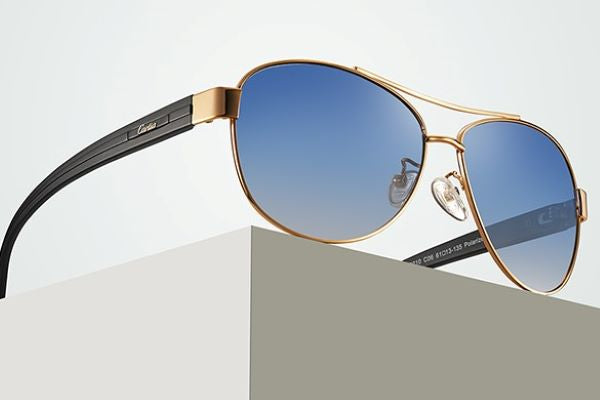What Is a Prism in Glasses?
Prism is triangular and made of plastic or glasses for the purpose of dispersing light into a spectrum or changing the direction in which light is reflected.
Prism lenses are special lenses that are prescribed by eye doctors and infused into regular lens prescriptions. The prism glasses do not include contain any focusing power, and therefore cannot any refractive errors. So, one of the most common uses for prism glasses is to correct diplopia or double vision. Double vision means someone sees two separate images of a single object. The prism glasses help to align the two images and correct the problem. The prism glasses can be used to improve binocular vision and reduce double vision, headaches, reading difficulties, and so on.
What is the best lens material?
Trivex is a special material from PPG. Compared with PC lenses, the refractive index is lower (only 1.53) but the Abbe number is higher (up to 45), which results in smaller dispersion and better image quality. At the same time, the impact resistance of the Trivex lens is 10 times higher than that of the PC. It is the only explosion-proof safety lens that can withstand external force twists and turns in the market at present.
Types of Optical Frame Glasses
The full-frame glasses have good strength, suitable for athletes and children to wear because the lens is completely protected by the lens ring. They are suitable for a variety of refractive parameters of the lens. The upper part of the lens ring is made of metal or plastic materials. The lower half of the lens ring is made of a very fine nylon wire like the lower part of the lens ring. Rimless glasses are lighter than full-frame glasses. Rimless glasses can be divided into parts type and integral type. The part type consists of a nose bridge (together with the nose pad) and two temples. The combination glasses are divided into two parts. Usually, the front group is equipped with colored lenses, and the rear group is equipped with lenses for correcting refractive errors. The folding glasses can usually be folded at the bridge of the nose and the temple to reduce the space when stored or carried and are mostly used for making reading glasses.
The origin of modern eyeglasses
The origins of modern glasses can be traced back more than 1,000 years. In the Middle Ages, the reading stones used by monks were glass spheres, sometimes filled with water and placed on objects to magnify them.Glassblowers in Italy created reading stones, similar to modern hand-held magnifying glasses. The reading stone can be placed on the wearer's nose or in front of the face. Later, Spanish craftsmen built the first cobra-framed temple in the 17th century. They tie ribbons or strings to the frames and tie them around the user's ear.
In the 18th century, Edward Scarlett created the first wearable glasses, providing more comfort for eyewear wearers. These early glasses had glass lenses embedded in heavy frames made of wood, lead, or copper. Natural materials of leather, bone, and horn were later used to make the frames. In the early seventeenth century, lighter steel frames were invented. As eyewear continued to evolve and prescription accuracy improved, the trend for eyewear to become more fashionable began. In the 18th century, bifocal lenses appeared, making it possible to correct upper myopia and lower presbyopia. Later glasses were designed to be fixed by a ribbon or by applying pressure to the bridge of the nose. In the 1980s, plastic lenses were introduced, providing a more durable alternative to glass lenses. Ultimately, the glasses used today are the result of centuries of technological and intellectual advances.
About the early domestic anti-reflection coating lens
Chinese coated lenses appeared in the mid-1980s. At that time, Europe (such as France and Germany) and Asia (such as Japan, Singapore, and Taiwan) had already launched coated lenses to the market, and the grade of lenses was evaluated based on the quality of the anti-reflection effect. Among them, Germany and France were the two leading countries in technology. Technically, the use of French original film material (referred to as H2) can reduce the effect by 99.98% (refers to the light transmittance, the same below). Almost you can not see the reflection, but the material is expensive. Therefore, the coating lens which is currently used in the world is born. The anti-reflection effect is controlled at about 98%, so the coating cost is greatly reduced. And it is accepted by consumers because it presents various colors, especially green. At the same time, because at the same time, it can be easily distinguished from non-coated lenses. It can reflect the high-grade film lens, and it is accepted by the sales staff.
How to adapt to progressive lenses?
People who are prone to motion sickness or have inner ear diseases may suffer dizziness, nausea, vomiting, and other symptoms due to their inability to tolerate the slight deformation of the visual objects, so they need to pay more attention when wearing them. For people who have not worn reading glasses before, it is not recommended to wear graded multi-focus glasses directly because their eyes will not be able to adapt quickly.
What Is Progressive Lens?
Progressive lenses, also called multifocal lenses, have three prescriptions in one pair of glasses. So, it allows you to see near, middle distance, and far objects without changing your glasses. The progressive lenses are designed for people who are over 40 years old who are both nearsighted and farsighted. The progressive lenses come with the following features:
- There is no distinct line between all visions(near, intermediate, and far).
- Most popular lens for anyone with presbyopia who wears
- Expanded intermediate zone for better computer vision.
From the above information, you may have known the differences between bifocal lenses and progressive lenses. As for progressive vs bifocal lenses, which one is better? It is difficult to judge because each of them has unique features. So, if you do not know choose which, you can listen to the eye doctor.










































